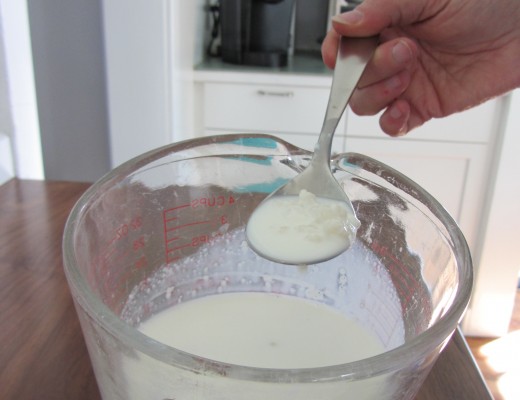
I know the correct pronunciation is “ka-FEER,” but I’ve always called it “KEE-fer” – hence the title of this post. If you’ve never tried the cultured milk beverage called kefir, you’re missing a healthy dairy treat. It’s good for gut health, as it provides beneficial bacteria that can actually colonize in the intestinal tact, where they take up the job of fighting off pathogenic yeasts. Many people who are lactose intolerant can enjoy kefir because the friendly bacteria consume most of the lactose.
I’ve been enjoying kefir for years – a little on my granola or just a small chug for a little protein boost. Unfortunately, most store-bought kefirs have a lot of sugar in them. So, when one of my classmates at Nutrition Therapy Institute offered to give me some of his kefir cultures so I could make my own kefir at home, I jumped at the chance.
The next day, my friend gave me a plastic bag with the milky “grains” of kefir culture and told me how to start making my own kefir at home. Of course, this came just a week or so after we’d had all kinds of food safety lectures at school. What about the four hour danger zone? I’m really going to leave the milk with the cultures at room temperature for 24-48 hours?
The first night when I brought home the plastic bag containing the live cultures, I forgot they were in my bag until I woke up at about 2 AM. The cultures! Must keep them alive! So I tiptoed down to the kitchen in search of milk and found that all we had was a quart of Organic Valley half & half. I figured anyone would be happy to be swimming around in that stuff, so into the glass measuring cup they went. Needless to say, the first batch was very rich – almost like creme fraiche. It was good with honey & fruit. It was even better as a dollop in the curried lentil and apricot soup with cilantro on top.
The next batch was made with ultra-pasturized organic milk. It was good, but I noticed there was a lot of whey that had separated from the solids. I had to gently mix it up before straining and using it.
The third batch was best, with traditionally pasteurized organic milk – Organic Valley’s Rocky Mountain Pastures milk that comes from family farms in Colorado and Wyoming. That’s what I’ve stuck with for my recipe. There is less whey separation, and the kefir has a nice tang and effervescence. So cool that I can now make local kefir wherever I am, by using my kefir grains to culture local milk.
The “madness” part of this kefir thing is the fact that owning kefir cultures is a little bit like having another pet. Have I stirred the kefir today? What’ll happen to the kefir when I go out of town for a few days? Can I count on my housemates to take care of them? Should I give them some kind of family name? Fortunately, the kefir can be slowed down and stored in the refrigerator. The grains of the culture can even be frozen for couple of months, making them one of the easier pets to tend to. I’m just lucky I have housemates who will care for my dog when I go to ExpoWest this weekend. It’ll be fun to talk with the kefir folks at the show.
Comments on this story